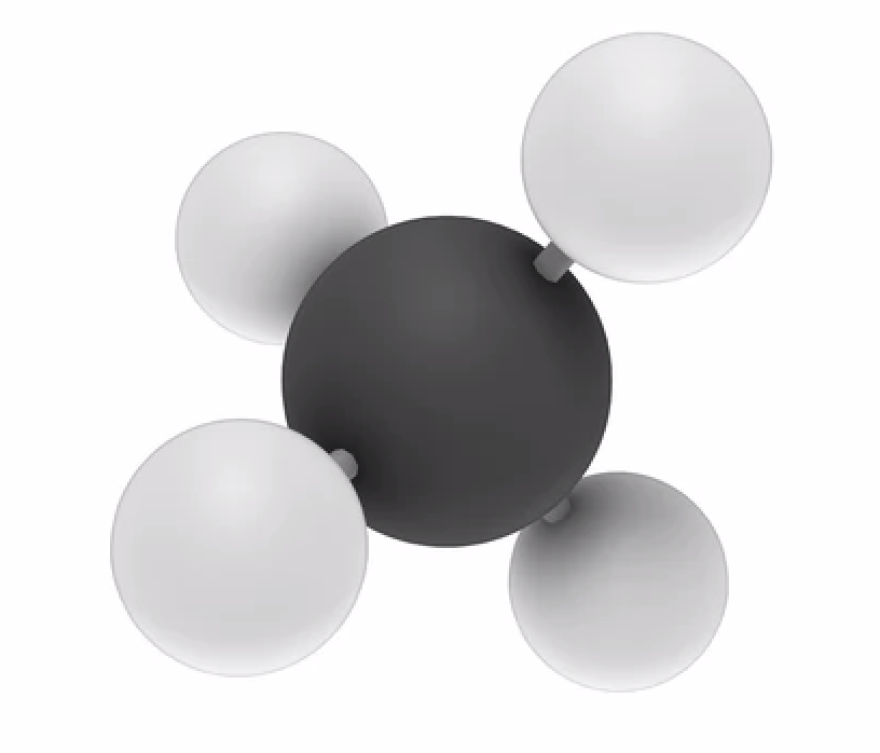Methane. It's the other greenhouse gas - less common and shorter-lived than carbon dioxide, but also a much more potent heat trapper.
If there's one chemical formula most Americans recognize, it's probably CO2. Carbon dioxide. The molecule now thought to be primarily responsible for human-caused climate change.
But carbon dioxide has a much less famous cousin that could also wreak havoc on the climate. Substitute four hydrogens for those two oxygen atoms and you've got methane, CH4, a major component in natural gas.
Methane is the most compact and efficient form of carbon-based fuel, leading to lower carbon emissions than oil or coal when it's burned. That's why people as disparate as President Obama and the billionaire Koch brothers have declared natural gas a critical part of reducing greenhouse gas emissions from electricity production.
There's a down side to methane's simple chemisty, though. It is much more efficient - at least 20 times more - than carbon dioxide at trapping heat in the atmosphere. Methane, itself, only lasts about ten years in the atmosphere, but it breaks down to carbon dioxide, which can stick around for hundreds of years. So, while methane currently makes up less than ten percent of American greenhouse gas emissions, it has a disproportionate impact in terms of warming.
"There's so much we don't know about methane, and it's potential impact is pretty significant."
- Jeff Seewald, WHOI
Just where does all that methane come from? The Environmental Protection Agency’s most recent Inventory of U.S. Greenhouse Gas Emissions and Sinks lists natural gas and petroleum production as the largest source, followed by livestock (think flatulence) and landfills. In all, human activities directly account for more than sixty percent of the methane entering the atmosphere.
The remainder comes from natural sources. Methane is produced by bacteria in places where there’s abundant food (a.k.a. carbon, usually from dead plants or animals) but no oxygen. The mud under wetlands and beneath the seafloor are two examples.
But the line between natural and human-caused methane emissions is becoming fuzzy, according to Sue Natali, an assistant scientist at Woods Hole Research Center.
Natali is particularly concerned about the prospect of large quantities of methane being released from Arctic permafrost as it thaws, due to human-caused climate change. Under current emissions scenarios, scientists expect half of surface permafrost to thaw this century.
That previously permanently frozen soil is extremely carbon-rich. It’s estimated to hold between 1,400 and 1,700 gigatons of carbon – nearly twice as much as is currently found in the atmosphere. Some of that is in the form of methane that could be released as permafrost thaws.
The bigger concern, though, is that rising temperatures will enable methane-producing bacteria to ramp up, and all that carbon will provide ample food. That could lead to an enormous infusion of methane into the atmosphere, which would intensify warming, which would lead to more thawing, which would … you get the idea.

“Scientists use the term positive feedback,” says Natali, “We mean positive, not that it’s good, but that it’s an amplification of climate warming.”
The recent discovery of three large craters in Siberia that appear to have been caused by a build-up of methane in thawing permafrost has raised the specter of impacts completely unforeseen by scientists.
There’s also been concern that the amount of methane seeping out of the seafloor is increasing due to warming. One climate scientist responded notably to an announcement by Stokholm University scientists that they were finding unexpectedly high levels of methane bubbling up from the seafloor:
“If even a small fraction of Arctic sea floor carbon is released to the atmosphere, we’re f’d,” Jason Box tweeted.
But Carolyn Ruppel, head of the Gas Hydrates Program at the U.S.G.S., says this could be a false alarm. Her group recently documented hundreds of methane seeps off the east coast of the U.S. Based on their findings, Ruppel says that there could be thousands more methane seeps that we haven’t discovered yet – not because they’re new; we just haven’t looked before.
That’s not to say that rising temperatures couldn’t increase the amount of methane coming from the sea floor. Warmer waters could thaw frozen pools of methane and increase bacterial production, as well. But Ruppel says most of that would be absorbed by the water before it had a chance reach the surface. To back that up, she points to studies that have found no increase in atmospheric methane levels above locations where methane is bubbling up from the sea floor.
Still, Ruppel says methane deserves more attention than it’s been getting. Natali and Jeff Seewald, a senior scientist in the Department of Marine Chemistry and Geochemistry at Woods Hole Oceanographic Instituion, agree.
"There's so much we don't know about methane and it's potential impact is pretty significant," says Seewald. "Considering it's potential, I think it does deserve significant attention."



